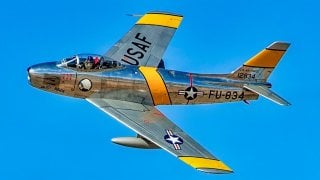All of the Reasons the F-86 Sabre Was So Hard to Fly
The earliest variants of the F-86 Sabre, which were rushed from the production line, could not out-turn the nimble MiG-15. However, the F-86 could outdive the MiG.
Meet the F-86: With nearly 10,000 units built, the North American F-86 Sabre is, by far, the most-produced Western fighter ever built. Built by North American, shortly after they created the famed P-51 Mustang, the F-86 was one of the first – and one of the most important – jet-powered fighter aircraft ever. At the time of the F-86’s debut, in 1947, jet technology was nascent and early jet fighters earned mixed performance reviews.
The transition from propellers to jet engines was difficult for both designers and pilots – and the Sabre is no exception.
F-86: An Early Jet-Powered Aircraft
The Sabre featured distinct design features that pilots took some time getting used to. Notably, the F-86 featured swept wings, and an all-flying tail – and did not feature leading-edge slats. The F-86 had a high accident rate, much of which was owed to a tendency to over-rotate on take-off. In fact, in 1972, a privately-owned F-86 over-rotated on take-off at the Golden West Sport Aviation Air Show in Sacramento, California. The jet barrelled through a fence, across a busy street, and into a Farrell’s Ice Cream Parlor. Twenty-two people were killed and 27 more were injured. The pilot survived with a broken arm and a broken leg.
A New Design Was Difficult for Pilots at First
Military pilots struggled with the Sabre, too. New F-86 pilots were trained at Nellis Air Force Base. Training casualties were so common that cadets were told that if they ever saw the flag at full staff, take a picture. Accident rate aside, the F-86 is best remembered as the U.S. Air Force’s primary fighter during the Korean War.
When the Soviet-made, swept-wing MiG-15 was introduced to the Korean theater, existing American straight-winged airframes like the P-80 Shooting Star and the F-84 Thunderjet were suddenly rendered obsolete. Rushing to match the new Soviet fighter, Americans rushed F-86s to Korea (while pushing existing straight-winged fighters into ground-attack duties. The F-86s arrival in theater set up one of history’s fiercest aerial rivalries between the F-86 and the MiG-15.
F-86: The Variants
The earliest variants of the F-86 Sabre, which were rushed from the production line, could not out-turn the nimble MiG-15. However, the F-86 could outdive the MiG. Nevertheless, the MiG remained superior with respect to service ceiling, acceleration, and rate of climb. Not until the F-86F was introduced, in 1953, were the Americans able to reciprocate the abilities of the MiG-15. Some pilots even claimed that the F-variant was marginally superior to the MiG. The new F-86 could be operated safely at speeds in excess of Mach 1, whereas the MiG needed to be kept around Mach 0.92 – giving American pilots a speed advantage.
Additional advantages F-86 pilots enjoyed: experience and training. American F-86 pilots, many of which were World War II veterans, had the benefit of combat experience over their North Korean counterparts. Plus, America had a robust pilot training program, which adequately trained new recruits for aerial combat. However, the Soviet Union did send its own pilots to Korea – pilots who also had World War II combat experience – and who helped mitigate the American experience and training advantages.
After Korea, Sabre pilots were initially credited with shooting down 792 MiGs while losing only 78 Sabres – a 10:1 kill ratio. However, these numbers were reexamined after the war. In reality, F-86 pilots likely only shot down about 200 MiGs or 25 percent of the initial estimate.
Still, the Sabre was a lynchpin of the U.S. Korean War effort – and a huge step forward in the development of jet fighter technology.
About the Author
Harrison Kass is a prolific defense writer with over 1,000 published articles. An attorney, pilot, guitarist, and minor pro hockey player, he joined the US Air Force as a Pilot Trainee but was medically discharged. Harrison has degrees from Lake Forest College, the University of Oregon School of Law, and New York University’s Graduate School of Arts & Sciences. He lives in Oregon and regularly listens to Dokken.


